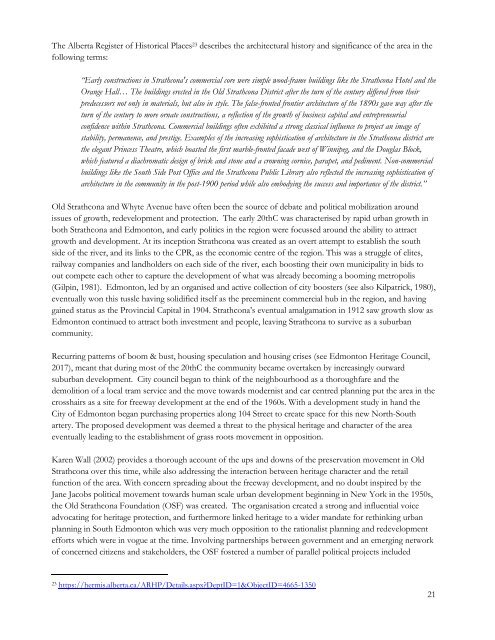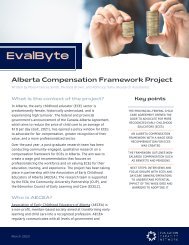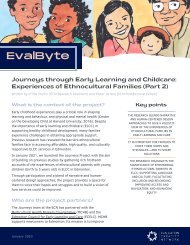Pursuing a Historic Urban Landscape Approach to Heritage in Edmonton
You also want an ePaper? Increase the reach of your titles
YUMPU automatically turns print PDFs into web optimized ePapers that Google loves.
The Alberta Register of <strong>His<strong>to</strong>ric</strong>al Places 23 describes the architectural his<strong>to</strong>ry and significance of the area <strong>in</strong> the<br />
follow<strong>in</strong>g terms:<br />
“Early constructions <strong>in</strong> Strathcona's commercial core were simple wood-frame build<strong>in</strong>gs like the Strathcona Hotel and the<br />
Orange Hall… The build<strong>in</strong>gs erected <strong>in</strong> the Old Strathcona District after the turn of the century differed from their<br />
predecessors not only <strong>in</strong> materials, but also <strong>in</strong> style. The false-fronted frontier architecture of the 1890s gave way after the<br />
turn of the century <strong>to</strong> more ornate constructions, a reflection of the growth of bus<strong>in</strong>ess capital and entrepreneurial<br />
confidence with<strong>in</strong> Strathcona. Commercial build<strong>in</strong>gs often exhibited a strong classical <strong>in</strong>fluence <strong>to</strong> project an image of<br />
stability, permanence, and prestige. Examples of the <strong>in</strong>creas<strong>in</strong>g sophistication of architecture <strong>in</strong> the Strathcona district are<br />
the elegant Pr<strong>in</strong>cess Theatre, which boasted the first marble-fronted facade west of W<strong>in</strong>nipeg, and the Douglas Block,<br />
which featured a diachromatic design of brick and s<strong>to</strong>ne and a crown<strong>in</strong>g cornice, parapet, and pediment. Non-commercial<br />
build<strong>in</strong>gs like the South Side Post Office and the Strathcona Public Library also reflected the <strong>in</strong>creas<strong>in</strong>g sophistication of<br />
architecture <strong>in</strong> the community <strong>in</strong> the post-1900 period while also embody<strong>in</strong>g the success and importance of the district.”<br />
Old Strathcona and Whyte Avenue have often been the source of debate and political mobilization around<br />
issues of growth, redevelopment and protection. The early 20thC was characterised by rapid urban growth <strong>in</strong><br />
both Strathcona and Edmon<strong>to</strong>n, and early politics <strong>in</strong> the region were focussed around the ability <strong>to</strong> attract<br />
growth and development. At its <strong>in</strong>ception Strathcona was created as an overt attempt <strong>to</strong> establish the south<br />
side of the river, and its l<strong>in</strong>ks <strong>to</strong> the CPR, as the economic centre of the region. This was a struggle of elites,<br />
railway companies and landholders on each side of the river, each boost<strong>in</strong>g their own municipality <strong>in</strong> bids <strong>to</strong><br />
out compete each other <strong>to</strong> capture the development of what was already becom<strong>in</strong>g a boom<strong>in</strong>g metropolis<br />
(Gilp<strong>in</strong>, 1981). Edmon<strong>to</strong>n, led by an organised and active collection of city boosters (see also Kilpatrick, 1980),<br />
eventually won this tussle hav<strong>in</strong>g solidified itself as the preem<strong>in</strong>ent commercial hub <strong>in</strong> the region, and hav<strong>in</strong>g<br />
ga<strong>in</strong>ed status as the Prov<strong>in</strong>cial Capital <strong>in</strong> 1904. Strathcona’s eventual amalgamation <strong>in</strong> 1912 saw growth slow as<br />
Edmon<strong>to</strong>n cont<strong>in</strong>ued <strong>to</strong> attract both <strong>in</strong>vestment and people, leav<strong>in</strong>g Strathcona <strong>to</strong> survive as a suburban<br />
community.<br />
Recurr<strong>in</strong>g patterns of boom & bust, hous<strong>in</strong>g speculation and hous<strong>in</strong>g crises (see Edmon<strong>to</strong>n <strong>Heritage</strong> Council,<br />
2017), meant that dur<strong>in</strong>g most of the 20thC the community became overtaken by <strong>in</strong>creas<strong>in</strong>gly outward<br />
suburban development. City council began <strong>to</strong> th<strong>in</strong>k of the neighbourhood as a thoroughfare and the<br />
demolition of a local tram service and the move <strong>to</strong>wards modernist and car centred plann<strong>in</strong>g put the area <strong>in</strong> the<br />
crosshairs as a site for freeway development at the end of the 1960s. With a development study <strong>in</strong> hand the<br />
City of Edmon<strong>to</strong>n began purchas<strong>in</strong>g properties along 104 Street <strong>to</strong> create space for this new North-South<br />
artery. The proposed development was deemed a threat <strong>to</strong> the physical heritage and character of the area<br />
eventually lead<strong>in</strong>g <strong>to</strong> the establishment of grass roots movement <strong>in</strong> opposition.<br />
Karen Wall (2002) provides a thorough account of the ups and downs of the preservation movement <strong>in</strong> Old<br />
Strathcona over this time, while also address<strong>in</strong>g the <strong>in</strong>teraction between heritage character and the retail<br />
function of the area. With concern spread<strong>in</strong>g about the freeway development, and no doubt <strong>in</strong>spired by the<br />
Jane Jacobs political movement <strong>to</strong>wards human scale urban development beg<strong>in</strong>n<strong>in</strong>g <strong>in</strong> New York <strong>in</strong> the 1950s,<br />
the Old Strathcona Foundation (OSF) was created. The organisation created a strong and <strong>in</strong>fluential voice<br />
advocat<strong>in</strong>g for heritage protection, and furthermore l<strong>in</strong>ked heritage <strong>to</strong> a wider mandate for reth<strong>in</strong>k<strong>in</strong>g urban<br />
plann<strong>in</strong>g <strong>in</strong> South Edmon<strong>to</strong>n which was very much opposition <strong>to</strong> the rationalist plann<strong>in</strong>g and redevelopment<br />
efforts which were <strong>in</strong> vogue at the time. Involv<strong>in</strong>g partnerships between government and an emerg<strong>in</strong>g network<br />
of concerned citizens and stakeholders, the OSF fostered a number of parallel political projects <strong>in</strong>cluded<br />
23 https://hermis.alberta.ca/ARHP/Details.aspx?DeptID=1&ObjectID=4665-1350<br />
21

















